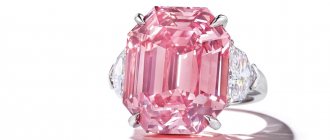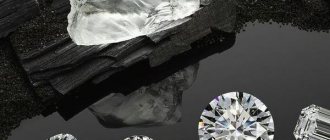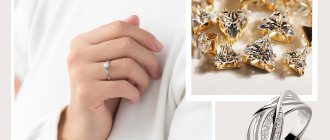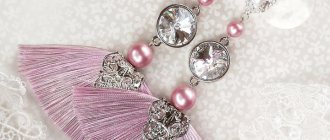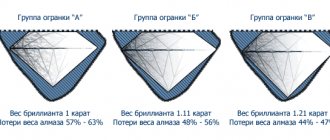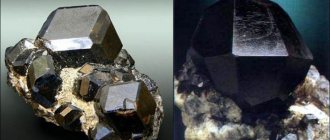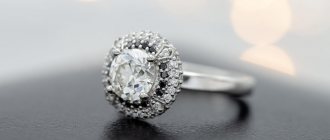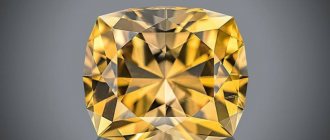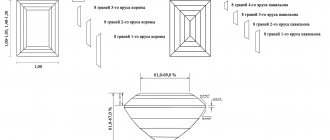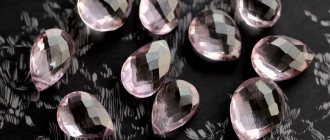The family-owned Asscher company has been synonymous with the world's finest diamonds since 1854. The history of the unique cut began in 1902, when Joseph Asscher perfected the geometric lines and cut of the square-shaped diamond. He patented it as the original Asscher cut, and it became extremely popular in the 1920s and 1930s during the Art Deco aesthetic.
Today Amsterdam is run by the sixth generation, Mike Usher and his sister Lita. Mike is responsible for design, production and finance, as well as new business development in Southeast Asia, while Lita is responsible for the North American and European markets, e-commerce platform and marketing. In the article you will read Mike's story about the cut that helped his name become part of the history of diamonds.
Joseph Asher is cutting the legendary Cullinnan Diamond
Differences between emerald cut and radiant cut.
Outwardly, these two cuts are very similar, but upon closer inspection, it is clear that their edges are structured differently. Key differences include:
— Cut.
The “emerald” cut belongs to the group of so-called “step cuts”. They have parallel sides and you can look through them. The radiant cut is classified as a "mixed cut". This means that it combines the functions of different types of cuts. It also has a stepped and brilliant cut. The general appearance of the radiant cut resembles a step cut, but the top and base of such a stone are processed according to the principle of a brilliant cut.
- Edges.
The facets of the emerald cut are shaped to be parallel to each other and to the belt of the stone. Radiant cuts have triangular and other quadrangular facets, but they are not rectangular in shape and they are not, for the most part, arranged in a parallel fashion. Upon closer inspection, you can see that the radiant cut does not look as linear as the emerald cut.
- Shine and radiance.
The facets of radiant cuts are positioned and shaped to enhance the brilliance of the stone. Unlike the “radiant” cut, the “emerald” cut does not give the stone additional characteristics of radiance and brilliance. A radiant cut diamond will be more sparkling and vibrant compared to an emerald cut.
- Purity.
Since the emerald cut does not maximize brilliance the way the radiant cut does, imperfections will be more visible on such a stone. The radiant cut, due to its brilliance, can successfully disguise the low clarity of a diamond.
4C of diamond = Cut+Carat+Color+ Clarity
Diamonds are classified into clarity groups depending on the presence of internal characteristics (inclusions, cracks, surface defects, the elimination of which will lead to significant weight loss), their quantity, location, brightness and color (characteristics visible through a 10x magnification lens are taken into account).
The clarity group of a diamond according to the Russian grading system (like the color group) depends on the weight of the stone. Thus, for small stones (up to 0.29 carats inclusive) there are fewer color groups than for medium and large ones (from 0.30 carats and above). In addition, for round cuts Kr-17 and Kr-33, regardless of the weight of the stone, a smaller number of purity groups are allocated.
Small Kr-17 gemstones are classified into 6 purity groups, and small Kr-57 diamonds into 9 purity groups. For medium and large stones there are 12 purity groups (see table). From the table it follows that a diamond with a clarity of 5 weighing up to 0.29 carats corresponds to a clarity of 7 for medium and large stones. Those. Defects and coloration that are difficult to see with the naked eye are detected only with characteristics of 7/7 (for medium and large stones). A trained eye, without the help of instruments, notices defects and color with characteristics of 6/6. Therefore, when buying large diamonds, it would be better to pay attention to the color and size that catch your eye.
Purity assessment is made at 10x magnification or with the naked eye. Defects that are detectable at higher magnification but not visible at 10x magnification are not taken into account. When assessing the impact of defects on purity, the size, nature, number, location, brightness/color of internal characteristics, and in some cases external characteristics are taken into account. To determine the position of a defect in a stone, the volume of the diamond is mentally divided into three zones of equal volume: central (the volume of the diamond, when viewed from above, located under the platform), middle and peripheral (near the girdle). According to established traditions, in Russia purity is called quality or defectiveness. On the contrary, in world practice (rating systems GIA, IDC, etc.) defects in cleanliness are called characteristics.
Clarity can be understood as the freedom of a gemstone from internal inclusions and blemishes, or as the relative position of a stone on the scale of a flawless diamond to a flawless diamond.
When we talk about a diamond's clarity, we are talking about having distinctive characteristics on the outside and inside of the stone. While most of these characteristics are an integral part of a rough diamond, occurring in the earliest stages of crystal formation underground, some are a result of the intense pressure the diamond is subjected to during the cutting process. If you imagine the incredible pressure with which a diamond is born, it is not at all surprising that many diamonds have inclusion cracks, defects, air bubbles and particles of foreign mineral rocks, both on the surface and inside the stone. The GIA grading system distinguishes 11 clarity grades, ranging from Intrinsically Flawless, a diamond that has absolutely no defects or inclusions even under 10x magnification, to Imperfect, a diamond that has serious flaws and inclusions visible even to the naked eye. glance. Cleanliness characteristics are classified as inclusions (internal defects) or surface defects. A defect (characteristic) is considered internal even if it appears on the surface of the diamond, if it cannot be removed by repolishing the stone without losing weight. All other things being equal, diamonds without defects are considered the most valuable. Diamond clarity is a collective concept that defines the transparency, absence or extent of internal or external defects of a diamond. Clarity shows how easily light can penetrate inside the diamond, reflect off its faces, and scatter into multi-colored rays. The purity of a diamond determines its rarity, attractiveness and durability, and therefore its value. Diamond was formed in the depths of the Earth gradually over several time phases. Moreover, the conditions - temperature, pressure, environment - were not always the same. This gives rise to natural features often referred to as internal diamond defects. Since a diamond is a creation not only of nature, but also of man, it may have external defects that appear or form during the diamond manufacturing process. The division into internal and external defects is conditional, since, for example, an internal crack can be formed as a result of processing a diamond, and an external defect in the form of a left natural edge is of natural origin. Diamonds, like most other minerals, have natural inclusions and defects in their structure. The fewer there are, the more valuable the diamond. Absolutely transparent diamonds are practically never found in nature; we can only talk about clarity at 10x magnification. If no defects are found, the stone is recognized as a pure diamond. It is not a fact that with higher magnification no inclusions will be detected either, but they are not taken into account in the cost estimate.
The procedure for describing defects and their characteristics when classifying diamonds into clarity groups in accordance with the Russian grading scale (GOST R 52913-2008)
- quantity
- size
- view
- location
Terms used in defining and describing the clarity of a diamond: in accordance with the Russian grading scale (GOST R 52913-2008)
internal defects - internal features located entirely inside the diamond or partially extending onto its surface, visible to the naked eye or at 10x magnification; external defects - defects located on the surface of the diamond and slightly penetrating deep into it
Terms used to describe internal and external defects in diamonds
dot - the smallest defect that has no volume inclusion - a defect that looks like a three-dimensional object of various sizes, shapes and colors located inside the diamond stripe - a defect in the form of a thin line crack - a break in the diamond that is completely internal or extends to the surface cloud - foggy (whitish) an area formed by an accumulation of tiny defects image visible to the naked eye - an image visible to the eye of a person with normal vision or through glasses (lenses) that correct poor vision to normal
Terms used to describe the extent of internal, external, polishing defects (working marks) and the degree of deviation from perfect symmetry of diamonds
with great difficulty visible (barely visible) defects - defects and deviations from perfect symmetry, which are very difficult to detect during a long and careful study of the diamond from all sides at 10x magnification; hardly visible defects - defects and deviations from perfect symmetry, which are difficult detect during a long and careful study of the diamond from all sides at 10x magnification visible defects - defects and deviations from perfect symmetry, which can be detected by carefully viewing the diamond from all sides at 10x magnification easily visible defects - defects and deviations from perfect symmetry, which can be easily detected by carefully viewing the diamond from all sides at 10x magnification, including clearly visible defects that are - defects and deviations from perfect symmetry, which can be easily detected at 10x magnification , including very clearly visible defects - defects and deviations from perfect symmetry, which are very easy to detect at 10x magnification, including easily visible with the naked eye
Terms used to describe the size of internal, external and polishing defects (working marks) of diamonds
the smallest defects - defects that do not have a discernible volume, having the form of dots or thin stripes, according to the degree of manifestation - with great difficulty visible (barely visible) small defects - defects that do not have a discernible volume or have a very difficult to distinguishable volume, according to the degree of manifestation - hardly visible minor defects - defects that have a difficult-to-see volume, according to the degree of manifestation - visible small defects - defects that have a discernible volume, according to the degree of manifestation - easily visible large defects - defects that have the appearance of three-dimensional objects, according to the degree of manifestation - clearly visible very large defects - defects that have the appearance of three-dimensional objects, in terms of degree of manifestation - very clearly visible
Determination of diamond clarity group according to TU 25-07.1319-77
| characteristics of purity group | cleanliness group | ||
| Kr-17 | less than 0.29 carats | more than 0.30 carats | |
| without defects | 1 | 1 | 1 |
| having defects: in the central zone there is one bright point, visible only when viewing the diamond from the pavilion; or in the middle and peripheral zones no more than two subtle light dots or one subtle stripe | 2 | 2 | 2 |
| having defects: in the central zone no more than three insignificant light dots or in the middle and peripheral zones no more than two defects in the form of insignificant dark dots or stripes | 3 | 3 | |
| having defects: in the central zone no more than two small dark spots, or in any zone no more than four small light spots, or no more than two stripes, or one strip and three small light spots, or in the peripheral zone one minor crack | 4 | ||
| having defects: in the central zone one small light cloud or one small crack, or no more than six defects in the form of small light stripes; or in the middle and peripheral zones no more than three minor cracks | 3 | 4 | 5 |
| having defects in any zones: no more than eight small scattered light defects in the form of dots, stripes, small cracks, bubbles, microseams and growth lines, or up to five small dark dots, or one minor graphite inclusion | 5 | 6 | |
| having defects in any zones: no more than eight small scattered defects (including those faintly visible to the naked eye) in the form of dots, stripes, small cracks, dust clouds or one small graphite inclusion | 7 | ||
| having numerous defects: in any zones no more than two small graphite inclusions or no more than two small cracks, or one small cloud in combination with a graphite inclusion, or one small crack in combination with a graphite inclusion, or several small cracks in combination with a graphite inclusion | 7a | ||
| having numerous defects: in any zones except graphite inclusions, including in the form of cracks visible to the naked eye | 4 | 6 | 8 |
| having numerous defects: in any zones in the form of graphite inclusions, or graphite inclusions in combination with cracks visible to the naked eye | 9 | ||
| having defects: in any areas of various types, visible to the naked eye, and transparent to view at least 60% of the diamond pavilion facets | 7 | 10 | |
| having defects: in any zones of various types, visible to the naked eye, and less than 60% of the diamond pavilion facets are transparent for viewing | 5 | 8 | 11 |
| dived | 6 | 9 | 12 |
Determination of diamond purity according to GOST R 52913-2008; this classification is currently used
characteristics of the purity group purity group central zone middle zone peripheral zone large and medium small less than 0.29 carats Kr-17 without internal and external defects without internal and external defects without internal and external defects 111 one tiny defect in the form of a light point, visible only when viewing the diamond from the side of the pavilion—— 222 — no more than two tiny defects in the form of light dots222—one small defect in the form of a stripe222no more than three small defects in the form of light inclusions—332—no more than two small defects in the form of dark inclusions332—no more than two small defects in the form of a stripe 332no more than two small defects in the form of dark inclusions— —432no more than four minor defects in the form of light inclusions432no more than two minor defects in the form of stripes432no more than one minor defect in the form of stripes and three minor defects in the form of light inclusions432——one minor defect in the form of a crack432one minor defect in the form of a light cloud——543one minor defect defect in the form of a crack——543no more than three minor defects in the form of dark inclusions——543no more than six minor defects in the form of light inclusions and stripes 543—no more than three minor defects in the form of cracks 543no more than eight small scattered defects in the form of light inclusions, stripes, cracks , transparent volumetric inclusions653up to five minor defects in the form of dark inclusions653one minor defect in the form of a volumetric dark inclusion653no more than eight small scattered defects in the form of light and dark inclusions, stripes, cracks, clouds, transparent volumetric inclusions753one small defect in the form of a dark inclusion753no more than two small defects in in the form of dark inclusions7a53no more than two small defects in the form of cracks7a53no more than one small defect in the form of a cloud in combination with a small dark inclusion7a53several small defects in the form of cracks in combination with a small dark inclusion753numerous small defects in the form of various inclusions and cracks864one large crack864numerous large defects in the form of various inclusions and cracks964numerous large defects in the form of various inclusions in combination with cracks964numerous very large defects of various types and transparent to view at least 60% of the faces of the diamond pavilion1074numerous very large defects of various types and transparent to view from 60% to 30% of the faces of the diamond pavilion1185numerous very large defects of various less than 30% of the diamond pavilion facets are visible and transparent for viewing 1296How to choose between radiant and emerald cut?
The emerald cut is a good choice if you want a diamond that is rectangular in shape and not too shiny or sparkly.
Just make sure that the emerald cut diamond you choose has a high enough clarity grade (VS1-VS2 or higher) as well as a high color grade (at least H or G). That is, check that the stone has no visible flaws or yellow tints.
Choose a radiant cut if you like the shape of an emerald cut, but also want your diamond to have the sparkle and sparkle of a classic round cut diamond.
How is it different from other unusual forms?
The Asscher cut was the first unique patented diamond cut ever created and is the predecessor to the emerald cut we know today.
When you look at an Asscher cut diamond, it is like looking into the endless reflection of mirrors.
For the Asscher cut, the diamond manufacturer needs perfect square rough diamonds similar to those used to create cushion or princess shapes.
A little about diamonds - color, clarity, cut and carats
Jewelry diamonds are graded using the 4C system: color, clarity, cut and carat. Color indicates how white or colorless a diamond is—colorless diamonds have a higher value. Clarity refers to how clear a diamond is and free of any defects (called "inclusions"). Diamonds that are clearer and less included have a higher value.
Cut refers to the shape and facets of the finished diamond - some cuts show off the brilliance and brilliance of the diamond better than others, which is why they may cost more. Carats refers to the weight of a diamond; larger and heavier diamonds will command a higher price.
Diamond cut: types, shapes and names
Princess cut diamond
The Princess rectangular cut diamond can also compete in beauty and popularity with the round crystal. This type of processing of jewelry diamonds was developed in the 60s of the twentieth century. But the “Princess” had predecessors - the “Baryon” and “Quadrillion” forms. These forms were carefully perfected by jewelers.
This is how a new type appeared, allowing you to admire a sparkling, acute-angled crystal of a square or rectangular shape. Moreover, Princess diamonds are not inferior in sparkle and play to their round counterparts, and much less source material is lost.
Asscher cut diamond
Another type of processing of diamond crystals in the shape of a rectangle. A worthy alternative to the “Princess”: in fact, this is a variety of emerald cut that has a square shape with truncated corners. This type of diamond cut has 58 facets, but there is also the Royal Asscher cut, which has 74 facets.
Suitable for clean stones without initial flaws, since the peculiarities of grinding and applying facets reveal defects. Whereas in the “Princess” type, all inclusions and scratches are masked.
Cushion cut diamond
Cushion is a quadrangular cut with wide edges and convex sides. The corners are softened and rounded. The girdle is shaped like a cushion, which is why this treatment is called cushion-shaped. The first such diamonds appeared at the beginning of the twentieth century and have been modified in every possible way since then.
Thus, the jewelry fashion house “Tiffany” has developed and uses a variety of “rectangular cushions”. Cushion crystals can differ significantly from each other - after all, when polishing, jewelers strive to preserve the mass of the crystal as much as possible and improve it.
Marquise cut diamond
The sparkling boat-shaped crystals of the Marquise diamond have a beautiful story behind them. Their prototype, the Navette diamond, weighing more than 15 carats, adorned the collection of Cardinal Mazarin. And the beautifully curved stones owe their name to the Marquise de Pompadour herself, a connoisseur of luxury jewelry.
According to legend, Louis XV wanted to present his passionate favorite with a crystal in the shape of her smile. Therefore, fashionable shuttle-shaped diamonds, which are gaining popularity in the 21st century, are a well-forgotten old thing in jewelry. And it’s great that this type has been restored: the oblong shape of the stones allows you to create real masterpieces, as it combines perfectly with crystals of other shapes.
Pear shaped diamond cut
The Pear diamond also has its own beautiful history, which began in the late Renaissance. At that time, two types of stone grinding were popular: “Rose” and “Briolet”. The Briolette shape repeated the outline of a drop.
Apparently, it was “Briolet” that became the forerunner of modern teardrop-shaped processing. The fancy, complex “Pear” has 56 facets and is a combination of a round crystal and the “Marquis” type.
Radiant diamond cut
The Radiant diamond is cut in the shape of a rectangle or square with an octagonal outline. Technologically, it is a combination of step and diamond types of processing. The corners of the crystal are truncated to increase sparkle.
Radiant is a rather rare crystal due to the specific grinding process; it is more often found among colored diamonds, as it improves their color.
These are the main types of processing of jewelry diamonds. But there are also heart-shaped diamonds, triangular ones, and other modifications of classic shapes.
The search for ideal parameters does not stop. The quality of diamond cutting is improving thanks to modern modeling technologies and the invaluable experience of the past.
What is the best cut for a yellow diamond?
Yellow diamonds are no less beautiful than colorless diamonds and, depending on the intensity of the color, can have similar value. However, yellow diamonds do not have the same reflective qualities as colorless diamonds, so round cut diamonds are not the best option for yellow diamonds.
Maintaining color vibrancy is more important with colored diamonds. Shiny or cushion ones are best suited for this. These cuts have a more square shape, which increases the depth of color in the diamond.
Royal Asscher Diamond Company
Company creation
In 1854, Joseph Isaac Asscher, a renowned artisan in the diamond industry, founded the IJ Asscher Diamond Company, named after his son Isaac Joseph Asscher, who followed in his father's footsteps and entered the diamond industry. He passed on his knowledge to his five sons, including Joseph (a prolific and consummate diamond cutter) and Abraham (a talented innovator and businessman). Together they became the most eminent diamond experts of the 20th century. Under Joseph and Abraham, the company was known as the Asscher Diamond Company and cut diamonds to decorate jewelry for world-famous boutiques and houses around the world. While one of the world's largest diamond polishing companies, the company was known for having private clients including royalty, celebrities and politicians.
Usher version
In 1902, Joseph Asscher developed and patented his eponymous original Asscher cut. [1] This symbolic cut was the world's first patented diamond cut, protecting it from being copied by other companies. The Asscher Diamond Company held its exclusive patent until World War II and enjoyed strong sales internationally, especially during the 1920s and 30s when the cut and the company were at the height of their success.
The original design had 58 step-cut facets, a small table, a high crown and a steep pavilion with cut corners. An accurate description would be an emerald cut square diamond with corners.
Asscher cut diamonds, also known as square emeralds, are roughly square in shape when viewed from above, but have the corners cut off to allow more light into the diamond. They typically have 50 or 58 edges, and their ideal length to width ratio is between 1 and 1.04.
The Asscher cut was a staple of Art Deco and Art Nouveau era jewelry, with straight lines and facet arrangements that made it ideal for the clean and graphic elements brought to life by movement.
Due to the arrangement of the facets, high crown and depth, Asscher lamps can produce outstanding brilliance and are known for creating a "hall of mirrors" effect.
Royal Asscher cut
Nearly 100 years after the original Asscher cut was conceived, Joseph Asscher's great-great-grandsons, Edward and Jupe Asscher, revised the design, adding sixteen additional facets to resemble the Cullinan II Imperial Crown Diamond.
The result is a square, step-cut diamond with 74 facets that absorbs light from all angles, creating the effect of an infinity pool of mirrors, a kaleidoscope of all the colors that make up the light spectrum, designed to capture the eye with the brilliance of the round cut and the intricacies of the emerald cut's expertly crafted angles.
Royal Asscher Round Diamond
By adding facets to the outside of the diamond, the Royal Asscher Round Brilliant Cut removes some of the darker elements that can be seen in a traditional round diamond, even when cut to perfection. The effect is a crisp, clean center that, although consistent with the shape of a round diamond, is noticeably different with 74 facets compared to the 58 facets of a regular diamond.
Royal Oval Asscher Cut
Inspired by the inner beauty of the subtle, flattering and popular oval shape, which is often irregularly cut, the Asscher family launched The Royal Asscher Oval Cut in 2022, like the company's other cuts, the patented Royal Asscher oval cut with 74 facets compared to the usual 58 regular rounds diamonds. Edward Asher (fifth generation) and Mike Asher (sixth generation) set out to master the creation of a consistently beautiful oval by playing with proportions and cut patterns, the diamond has what is commonly called a modified brilliant cut style.
Royal Usher Pillow
The Royal Asscher Cushion Cut was released in 2022, the diamond has an additional cut on the table and at the bottom of its design, which enhances its beauty, bringing out the potential of a diamond's brilliance without losing the soft, soft elegance of the cut. Like other Royal Asscher diamond cuts, the design is patented.
Diamond Excelsior
In 1903, the 997-carat (199.4 g) Excelsior Diamond was the largest diamond ever found. Proper processing of the gemstone required skillful handling: inclusions in a rough diamond prevented it from being polished as a single stone. Abraham Asher was charged with splitting Excelsior; To minimize imperfections, he cut ten diamonds from the stone, which were mostly sold to anonymous buyers. There are many rumors and myths about the whereabouts of diamonds.
The Excelsior diamond was the centerpiece of the 2003 Victoria's Secret Fantasy Bra, valued at approximately $13 million, and the bejeweled panties, valued at an additional $1 million.
Diamond Cullinan
In 1905 the Cullinan Diamond was discovered. It was a legendary find weighing 3,106 carats (621.2 g), which instantly became famous throughout the world. The diamond was presented to King Edward VII, and he invited the Ussher brothers to London to discuss splitting the diamond. It was decided that Joseph Usher would divide Cullinan into three parts to be included in the rough diamond. Nine large stones were cut from it, the largest being Cullinan I, weighing 530.20 carats (106.040 g).
In February 1908, a prominent crowd gathered to watch Joseph Asher split a huge stone. To get the big, beautiful diamonds, he had to get to exactly the right place in Cullinan. On his first strike, his blade broke, but the stone remained untouched. He dismissed everyone present and set to work creating larger and stronger instruments.
The following week, armed with new tools, Joseph resumed his work, not allowing anyone but the notary into the editing room. Urban legend has it that Joseph lost consciousness after hitting the Cullinan Diamond with a powerful blow. He later commented that the adrenaline rushing through him the moment the rift became so strong, all he could think was to examine the stone again and again and check its workmanship before rushing into the next room to share the good ones. news. The Cullinan diamonds were later polished and ready to take pride of place in the UK's Crown Jewels collection.
The Second World War
During the Battle of the Netherlands in World War II, the Nazis, as part of their extermination plans, broke into the headquarters of the Asscher Diamond Company in Amsterdam and confiscated its diamonds. Because the Asher family were Jewish, they were deported from the Netherlands and placed in concentration camps along with almost all of the company's 500 master polishers. Most of the Usher family and more than 96 percent of the polishers were killed by the Nazis.
During the war, the patent on the original Asscher cut expired. Because no one renewed the patent, other companies began using the Asscher cut, leading to confusion in the market regarding the origin of many Asscher cut diamonds. Some companies have chosen to call their Asscher cut diamonds square emerald cut. Many of these diamonds were cut for harvest and did not necessarily conform to Joseph Asscher's original proportions calculations for the Asscher cut, which specified parameters for the diamond's crown height, table size, and facet alignment.
After the war
Only ten members of the Usher family and fifteen of the five hundred polishers survived the Holocaust. Although it was once the diamond polishing capital of the world, Amsterdam's diamond industry was virtually destroyed during the war, including the Asscher Diamond Company. Subsequently, Antwerp became a major diamond polishing center.
In 1946, Jupe and Louis Asscher were invited to use their experience to create a new company in New York, but they chose to remain in their home in Amsterdam and rebuild the Asscher Diamond Company. From there, the company began to explore new markets in the 1950s and 1960s and became a renowned diamantaire in Japan.
Royal title
In 1980, Her Majesty Queen Juliana of the Netherlands granted the Asscher Diamond Company a royal title in recognition of the leading, centuries-old role that the company and the Asscher family have played in the diamond industry. With this honor, the Asscher Diamond Company became the Royal Asscher Diamond Company.
Authenticity
The Usher family received international design patents for all of their cuts, so they cannot be legally counterfeited; Royal Asscher is also a trademark and the company holds exclusive rights to the name. To further ensure authenticity, each diamond is laser-etched with the Royal Asscher logo and an identification number that belongs to only one diamond. The number is registered with the Royal Asscher Diamond Company in Amsterdam and the diamond comes with a Royal Asscher certificate.
Specialists in unusual cuts
Today, Royal Asscher Diamond Company are the specialists in Fancy Cut. Consumer understanding of diamonds has improved with the advent of the Internet, online retailers and social media. With today's consumer ready to buy online and people looking for something personal and rare, there has been a growing interest in regular fancy shaped diamonds. Non-round shapes were more difficult for buyers to find and buy. Round shapes have always been popular, and fancy shapes tend to be harder to find in pretty options. This is because there is no universal cut grading system for fancy shapes, whereas round diamond shapes fall into the ideal category (as the best in cut class). In an effort to create a new level of excellence in this class, Royal Asscher, as renowned shape pioneers, conducted research and development and introduced four cuts that the company claims are shapes that are the highest expressions of beauty, each cut having 16 more facets compared to their universal analogues.
Present tense
The fifth and sixth generations of the Asher family lead the international company. Edward Asher, father works with his daughter Lita and son Mike.
In March 2022, Edward Usher announced his departure from the company. Following his departure, his daughter Lita Asher and son Mike Asher will become co-presidents of the firm. [2]
Which diamond cut sparkles the most?
The most brilliant cut of a diamond is the round brilliant. The round brilliant cut has been scientifically developed and proven to provide maximum brilliance, flame, flash and sparkle. If the raw gemstone is of high quality and if the cut is done correctly, the gemstone will catch light and reflect it off the facets within the gemstone, which then reflects back off the stone, creating maximum brilliance.
Round cut diamonds are extremely popular. Their high quality and demand are accompanied by a higher price.
Want to know more about diamond rings? Check out our article “Do Diamond Rings Have Serial Numbers?”
Why is cutting needed?
Before we look at the different types of cutting, let's understand what cutting is and why it is needed. For the most part, precious stones are crystals of a certain substance; they grow in a certain liquid composition, which was formed under special conditions. Each crystal has its own crystal lattice and grows according to its laws. Surely everyone remembers the school experience of growing salt crystals. As a result, crystals of different shapes are obtained, for example, a diamond has the shape of two pyramids connected at the bases (octahedron), emerald crystals have a hexagonal prism, and ruby and sapphire have the shape of a spindle with edges.
As you can see, nature does not create gemstones in the form we wear. And this is the merit of a person who studied the optical properties of each crystal and developed cutting parameters at which the maximum amount of light entering the stone is directed to our eye. Stones cut to proportions and angles closer to ideal and calculated mathematically have a better play of light and attract more attention.
What are the most famous Asscher-cut jewels?
The world's most famous Asscher cut is the 33-carat Elizabeth Taylor Diamond. It was given to Taylor in 1968 by her husband Richard Burton, but is believed to have been cut before the 1920s. Taylor wore a ring with this diamond throughout her life. After her death, it was auctioned for $8.8 million. In 2011, the Gemological Institute of America classified it as a Type IIa Exceptional Fine Diamond with a VS1 clarity.
Main cutting stages
The process of turning rough diamonds into polished diamonds is complex and responsible. The value of a stone is determined not only by its size, carat, color and clarity, but also by the type of cut and the work of the master jeweler. Mathematical precision is required for the crystal to sparkle with all its faces, reflecting the light falling on it.
The time it takes to process one crystal depends on:
- depending on the chosen shape - the more faces, the longer the process takes;
- size of the mineral - large ones take longer to cut, but there are small specimens that are valued more expensive than large ones due to painstaking and lengthy labor;
- the condition and newness of the equipment - the more modern it is, the faster things go;
- experience of the master - beginners are afraid to spoil the future diamond with an unnecessary movement of the hand.
The Golden Jubilee Diamond, which has 102 facets, was presented to the monarch of Thailand. It took 2 years to create it. Such instances are rare; work is usually carried out as usual. Average cutting time:
- preparation for cutting – 3–4 hours;
- sawing – a 1 carat stone needs to be sawed for 6–8 hours;
- grinding – 3–4 hours;
- polishing – 1–2 hours.
It turns out that it takes from 13 to 24 hours of continuous labor to create one diamond, which is 2-3 working days.
View this post on Instagram
Posted by about_royal_jewellery (@about_royal_jewellery) Nov 3, 2022 at 9:25 am PDT
How are diamonds processed?
Diamond cutting is complicated by the hardness of the mineral - 10 out of 10 on the Mohs scale. For each stage of production, certain devices are used.
- Diamond cutting is carried out using a laser or diamond saw, the rotation speed of which reaches 9000 revolutions per minute.
- Peeling is done with a diamond cutter; this is rough processing, during which contours and future edges are outlined. This produces diamond dust, which is used in the production of diamonds.
- Cast iron discs are used for grinding, which barely touch the crystal when rotating. First, the upper and then the lower facets (beveled side edges) are polished.
- Polishing is carried out using a horizontally positioned iron polishing wheel. From time to time, the product is washed with water to remove waste and shavings.
- The final stage is boiling in sulfuric acid. This cleans the diamond of dirt, oil, and diamond powder.
Main types of stone cuts
The entire cut can be divided into several types. Shape: circle, rectangle, square, oval, pear, marquise, heart, pillow. And according to the type of edges themselves - stepped and diamond. The step cut is distinguished by its wide rectangular facets with large, bright, but infrequent flashes. Vivid examples of step cuts are emerald (rectangular) and asscher (square). The diamond cut has smaller facets in the form of triangles and diamonds; the flashes of light generated on such facets are weaker than on the stepped facet, but more often. The diamond cut is much more common - circle, radiant, princess, marquise, heart, oval, cushion, drop.
How did cutting evolve?
Almost 100 years after the original Asscher cut was first conceived, the design has been revised with 16 additional facets added to make it similar to the Cullinan II Diamond of Great Britain's Imperial State Crown.
The result is a 74-sided step-cut square diamond that absorbs light from every angle, creating an infinity pool effect and a kaleidoscope of all the colors that make up the light spectrum. It is created to catch the eye with its brilliance.
